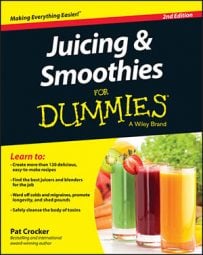Fresh, whole foods from juices and smoothies provide the same nutritional benefits to Fido and Fluffy as they do to you. Chemicals and empty-calorie foods have nothing in them to build bones and muscle and maintain your pet’s eyes, ears, internal organs, and coat. Pets thrive on fresh vegetables and fruits; organic chicken, lamb, or beef; and legumes and whole grains, such as brown rice, oatmeal, barley, or millet.
Although smoothies and juices may not be ideal, your precious four-legged friend can benefit from the roughage that’s left over from the extraction of the juice from whole fruits and vegetables. You can use this pulp to supplement your pet’s wet or dry kibble, or you can mix it with cooked meat, legumes, and whole grains.
In general, a balanced meal for a dog is made up of about 25 percent fruits and vegetables, 25 percent meat and legumes, and 50 percent cooked grains; for cats, it’s about 25 percent fruits and vegetables, 55 percent meat and legumes, and 20 percent cooked grains.
Before setting out to revamp your pet’s diet, do a bit of research into the amounts and kinds of whole food that are best for your animal. A great resource is Home-Prepared Dog & Cat Diets, 2nd Edition, by Patricia Schenck (Wiley-Blackwell).

